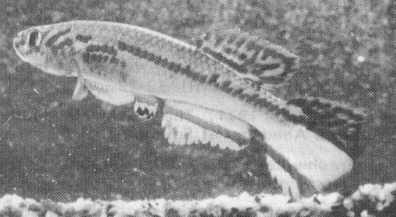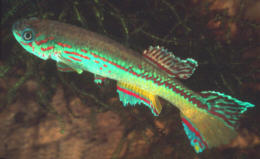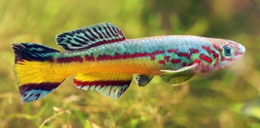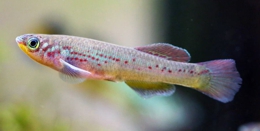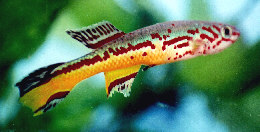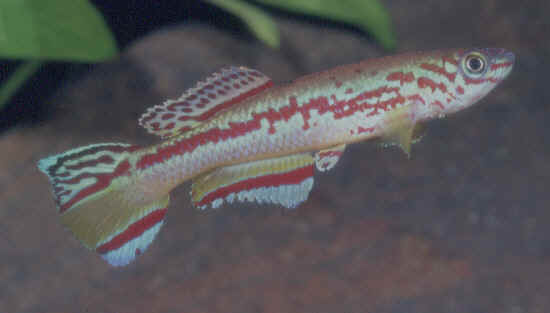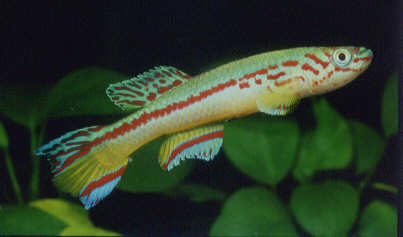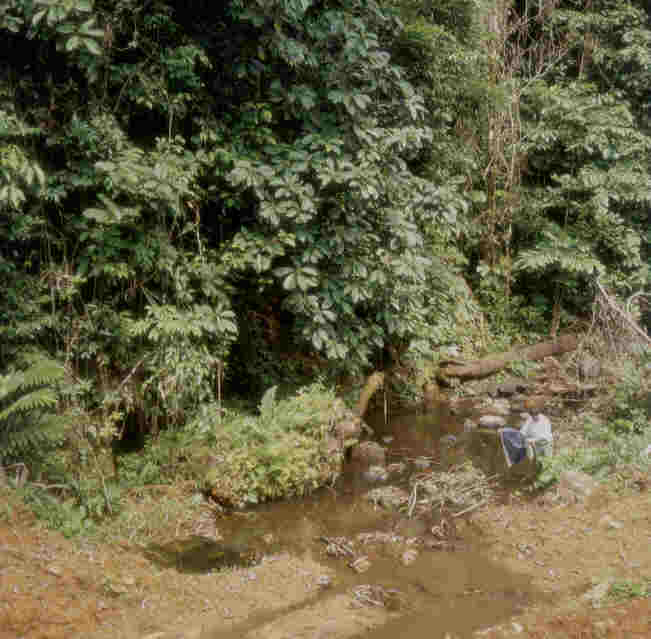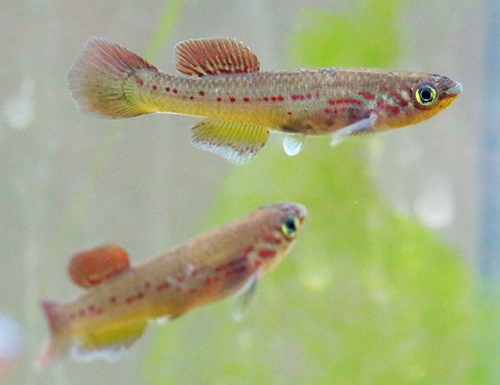Fundulopanchax amieti (Radda 1976)
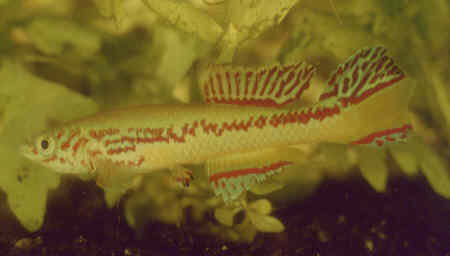
A fish I had in the early 1980's
| Meaning of Name |
After Professor J.L.Amiet, Director of the Zoology Museum, faculty of sciences, University of Yaoundé, Cameroon. |
||||||||
| First Description |
Radda A.C 1976. (Aphyosemion amieti). Neubeschreibung von Aphyosemion amieti nov. spec. aus Kamerun und Aphyosemion deltaense nov. spec., aus Nigeria. Aquaria 23: p 52-55, figure 2. |
||||||||
| Size |
7 cm. |
||||||||
| Meristics |
|
||||||||
| Karyotype |
|
||||||||
| Sub-Genus |
Paraphyosemion |
||||||||
| Group |
ndianus |
||||||||
| Synonyms |
|
||||||||
Populations
|
C 89 / 31 -
Somakak -
|
||||||||
| Type Locality |
A forest stream on the road to Koupongo, 500 metres west of Somakak, Sanaga basin, Cameroon. |
||||||||
| Distribution |
Restricted to relict areas of the Sanaga River basin, Cameroon. They are replaced to the south by the A.cameronense group in the Nyong drainage area & Fp.puezli to the north in the Wuri River system. |
||||||||
| Habitat |
Biotope of Fp.amieti at Somakak. Photo courtesy of Ed Pürzl. Found in deep, stoneless, marshy areas created by the action of fast flowing streams, also in forested areas. Also shallow, marshy areas of rain forest brooks. Radda took measurements on the 2nd December 1974 & found air temperature 27'C, water temperature 24.8'C, pH 6.5, DH 0.2. Sympatric sp. include Fp.puerzli, A.riggenbachi, A.franzwerneri, Epiplatys sexfasciatus, Alestes longipinnis & Barbus guirali. |
||||||||
| Distinguishing Characteristics | A
bright yellow wedge runs from the middle of the caudal fin to the chin
area. Also, a row of red spots, sometimes joined, run from behind the
pectoral fin to the outer extremity of the caudal fin. This (broken) line
seperates the yellow wedge from the blue area on top of the body. Distinct colour pattern. No other sp. could be confused with them. |
||||||||
| Colour/Pattern Variability | Low. | ||||||||
| History |
Discovered by A.C.Radda in 1974. The type material was found by Ed Pürzl in February 1975 in the lower coarse of the Sanaga River System. First recorded introduction into the BKA was in the later part of 1975. |
||||||||
| Breeding Notes |
This is a semi-annual sp. laying eggs in bottom mops or peat/fibres or silver sand. When this sp. first began to circulate in the
UK their was a great deal of material published in BKA Newsletters from
members who had had success with peat spawning & none with mop spawning
& vice versa. I have spawned this sp. in both peat & mops &
have had success in hatching & raising a small number of fry on,
although the parents were observed to go through periods where no eggs
were layed until the set up was changed to the opposite they were accustomed
to. Fp.puerzli also reacts this
way. Eric Bowden in BKA newsletter No. 357, June 1995 reported getting shell less eggs. These 'naked eggs in a few cases developed & even produced fry.
Young females C89/31 Édéa-Yaoundé 18 km just sexing out. Photo courtesy of Michael Pidwirny. A report by Fred Wright in BKA newsletter No.136,
December 1976 stated that by using the dry storage method eggs were
ready to hatch in 21 days. This was found to be the optimum period resulting
in healthy fry. Longer periods of drying were found to be detrimental
& eggs would even disintegrate. Ian Sainthouse wrote a breeding account in BKA
newsletter No.145, September 1977 in which he recommended incubating
eggs in water as he had a 90% hatch rate but little success using the
dry storage method. Jaroslav Kadlec in BKA newsletter No.207, November
1982 gives a breeding report in which he found them easily bred in an
4-6 litre tank. Water temperature range of 23-27°C, pH 6-7, DH 5-15.
He recommended a weekly water change of 25-50%. |
||||||||
| Diameter of Egg | 1 - 1.2mm | ||||||||
| Remarks |
This is an extremely colourful sp. which is fairly easy to maintain & spawn. Eggs can be taken from mops & incubated on a layer of damp/wet peat or capillary matting (which I found a little less effective). This method is good to observe the growing embryo's. |
